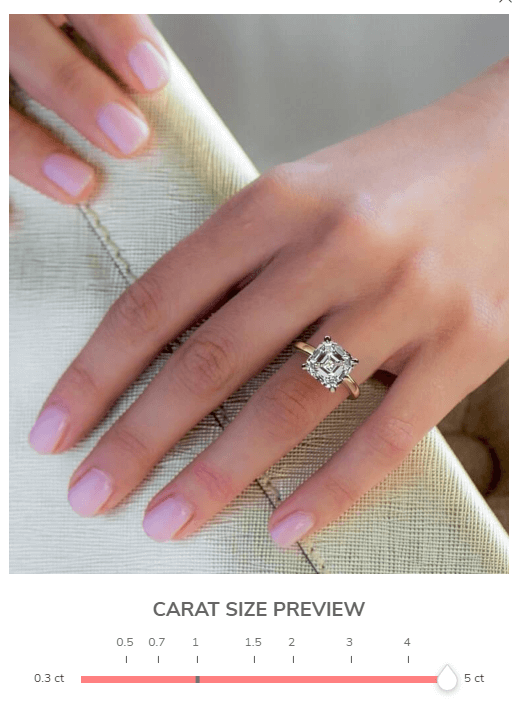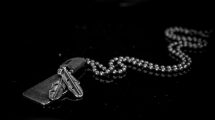As Wedding Know How editors, we write about things that we love and we think you'll like too. We have affiliate partnerships and sponsorship and may generate some revenue from these at no cost to you.
The Asscher cut, sometimes mistakenly called a square emerald, is stylish, versatile and classic. It’s the perfect cut for a bride who loves vintage sophistication and a dramatic look. Here we outline everything you need to know about the Asscher cut for engagement rings.
What is the Asscher Cut?

See more Asscher cut engagement rings here.
The Asscher cut is named after its inventor, Joseph Asscher, who created this diamond cut in 1902. Joseph Asscher was one of the founders of the famous Asscher Diamond Company (today renamed to Royal Asscher Diamond Company) based in Holland. The cut originally had 58 facets and was patented by the Asscher company.
WWII saw the destruction of the Amsterdam diamond industry and companies like the Asscher Diamond Company. However, after the war, remaining members of the Asscher household banded together to rebuild the company. They were rewarded by the Queen of Holland who granted the company the title of ‘Royal’ as a tribute to their contributions in the diamond industry.
Today’s Asscher cut was improved in 1999, and a new cut known as the Royal Asscher Cut with 75 facets, was introduced. This is also patent protected and only the Royal Asscher company can produce this.
Features of the Asscher Cut

See more asscher shape diamonds on James Allen here
- At first glance an Asscher cut might appear like a square shape, but it’s actually octagon shaped, with 4 long corners and 4 short ones.
- When you look at an Asscher from the front view, you’ll notice a windmill like effect with concentric square facets extended from the middle to each of the four shorter corners.
- When viewed from the side, the Asscher has a bulging pavilion.
- Asscher cut diamonds are typically square, with a length to width ratio of around 1.00 to 1.05.
- Unlike brilliant cut diamonds, Asscher is a step cut with long open facets that have a different type of light interaction than brilliant cut stones.
- It’s a more durable shape than most other diamond cuts as it has no sharp pointed corners.
- The Asscher is a deep cut and has a lot of the diamond beneath the surface. This can make the cut look smaller than another of similar carat weight.
Why the Asscher Cut is Excellent for Engagement Rings
The Asscher cut is one of the top 10 diamond cuts today, and although it’s not the most popular, it has a lot to offer as an engagement ring stone.
For one thing, the Asscher is a durable cut which means that it can take the daily knocks of life and remain largely unscathed. Unlike cuts like pear, marquise, or princess, the Asscher has no sharp corners and its bevelled edges also add a level of security.

Asscher cut diamond in a vintage setting. See it here.

Asscher cut diamond in a modern halo setting. See it here.
Another point to note is that Asscher diamonds are very versatile. They look stunning in vintage engagement ring settings, especially in the Art Deco style, due to the clean, crisp and geometric look of the cut. But when set in contemporary styles, the Asscher adapts well and makes for a stylish, modern-looking engagement ring.

Vintage Asscher diamond ring with ruby in an Art Deco style by Three Graces Too. See it here.

Asscher diamdon with emerald side stones by Diamond Violet. See it here.
Asscher diamonds also pair well with other gemstones, especially with rubies, emeralds and sapphires. Because the cut isn’t overly brilliant, it tends to work harmoniously with these less brilliant gemstones, creating a beautiful effect without outshining them.
This cut is associated with glamor, confidence and an old-world sophistication. They’re perfect for someone who loves unique designs and a vintage touch.
How to Choose an Asscher Cut Diamond
If you’re looking for an Asscher diamond, it helps to know the quality criteria to ensure that you’re getting the best value for your money. Here’s how to pick an Asscher in relation to the famous 4Cs of diamonds:
Choosing Asscher Cut
Although cut is considered king when it comes to colorless diamonds, diamond grading labs don’t provide a cut grade for fancy cuts like the Asscher (just for the record, all cuts except the round brilliant are called fancy cuts). This means that you’ll need to evaluate the stone by yourself. Here are the main parameters to bear in mind:
- Depth: a percentage of 60% to 67% depth will give you diamond that’s not too deep to have too much diamond hidden beneath the surface and not too shallow to sacrifice sparkle
- Table: a percentage between 55% to 69% will give a perfectly proportioned table size
- Length to Width Ratio: for the perfect square look opt between 1.0 to 1.05 but you can go up to 1.60 for a more rectangular look. more than this and your Asscher will look too narrow.
- Polish/Symmetry: choose between Very Good or Excellent for the best look. Perfect symmetry is necessary for an Asscher to look its best as it’s easy to see when the facets aren’t well aligned.
Poorly cut Asscher diamonds can have what’s known as windowing and extinction.
Windowing refers to a lack of light return, which results in a diamond that looks like glass while extinction refers to darkened areas in the diamond caused by poor alignment.
Choosing Asscher Color
Asscher cut diamonds tend to show color, due to the open nature of its facets. It retains color, showing even slight tints in the stone as it doesn’t have the distracting sparkle of a brilliantly faceted diamond.
The color grade you choose will also depend on the setting color of your ring.
- For yellow or rose gold settings – you can drop down to an I grade
- For white metals – try H color grade or higher
If you like a warm toned diamond, then drop down as far as you feel comfortable with the look. Color is really a matter of preference, so go with what feels and looks right to you. And because each color grade up increases significantly in price, drop as far down as you can go because… why pay for something you may not even notice?
Choosing Asscher Clarity
Like color, Asscher cuts tend to show imperfections and inclusions in the diamond. It isn’t a forgiving cut as the clear facets tend to show the flaws within. While clarity grades above VS1 are generally recommended, the truth is that when choosing your diamond the clarity grade doesn’t matter.
What matters is whether or not the diamond is free of visible inclusions. For this, ensure that you carefully examine the actual diamond, in person or via HD videos, from all angles. Use magnification and check for flaws. You might even be able to find a stunning Asscher cut from an Included category.
Choosing Asscher Carat Weight
The Asscher cut isn’t as expensive as some other cuts out there, particularly the round brilliant. For this reason, you may have enough budget left over to opt for a larger Asscher without compromising on quality. Generally, try to stay under standard sizes like 1 carat diamonds or 2 carat diamonds, instead opting for non-standard weights like . 19 or 1.73.

Carat Size Preview Option on James Allen
Chances are you’ll be able to save significantly as most people go for standard weights which make them more expensive. If you aren’t sure how a specific size will look on your finger, check out the Carat Size Preview options that many retail stores offer.
Asscher Cut vs. Other Square Diamond Cuts
The Asscher is a very distinct looking diamond cut, and there really isn’t another that looks quite like it. Here’s how the Asscher stacks up against other popular diamond cuts:
Asscher Cut vs. Emerald Cut
There’s a misconception that the Asscher cut is just a square emerald, but there are differences between these two cuts that distinguish them from each other. If you want to know about the differences between these two cuts in detail, we recommend reading our article on the topic.
Emerald cut diamonds appear larger than Asscher because they tend to be more shallowly cut. Emerald cuts have a flat culet (the bottom facet of the diamond) whereas the Asscher has a pointed culet. This is what gives the Asscher its attractive look, drawing attention to the center of the stone when viewed faceup. Emerald cuts are also typically rectangular and while they have the same number of facets (58) the Asscher cut also has the more brilliant modified version with 75 facets. The emerald cut is also much older than the Asscher and has been in use for centuries.
Asscher vs. Princess
The princess cut is the most popular square shaped diamond cut and while at first glance the two cuts appear similar, they couldn’t be more different. The princess has four sharp corners whereas the Asscher has truncated edges, which makes it less vulnerable to chipping and breaking. The Asscher, unlike the princess cut, also doesn’t snag on every items like clothes or hair. However, the princess cut is much more brilliant because of its dazzling array of carefully placed facets. It was invented to offer a square alternative to the round diamond with its faceting aimed to enhance its brilliance. If you’re after a brilliant square shape, then the princess cut is probably the better option for you.
Asscher vs. Cushion
The main difference between these two cuts again lies in the faceting structure. The cushion cut has more facets and has more sparkle than the Asscher. In terms of physical appearance, the cushion and Asscher cuts are very similar – both have beveled edges, truncated corners and an octagonal look. However, the cushion has a more arched, curved appearance whereas the Ascher is more geometric, with clear, straight lines.
Before You Buy Asscher Cut Diamonds
Always purchase from a vendor with a solid track record to avoid being ripped off. While physical stores give you the benefit of seeing the diamond in person prior to purchase, online stores offer you more convenience, variety and competitive prices. You’ll also be able to view the diamond in unhindered magnification, sometimes up to 40x with a 360 degree view.
If you aren’t sure whether an Asscher diamond is right for you, we recommend trying out the free Home Preview Service offered by With Clarity. This service allows you to customize up to 2 rings according to your specifications, which will then be delivered to you to try out for a few days to ‘test drive’ the ring style. There is no charge or commitment for this service and no hidden ‘catches’.
For the best diamond display technology, excellent service and quality of products, we recommend searching on James Allen for your Asscher Diamond.
For a wide variety of options, competitive prices and great customer service, check out Blue Nile’s Asscher diamond range.








